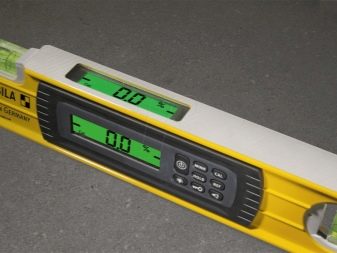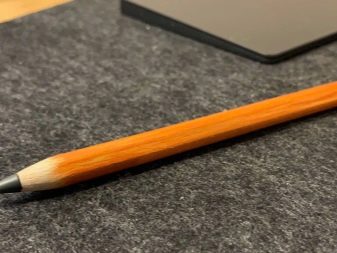Cornices are an indispensable part of any bathroom. They not only qualitatively protect the floor covering and the walls of the bathroom from splashing water, but also effectively zoning the room. In this material you will get acquainted with the varieties of eaves for bathrooms, as well as with the features of the selection and installation of these structures.

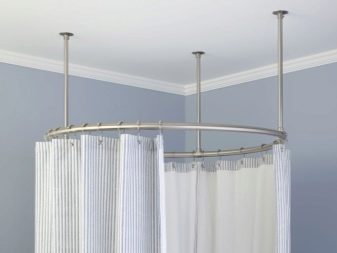
Features and purpose
Among the elements that form the interior of the bathroom, it is possible to single out the curtain and the cornice on which it is placed. This element plays the same important role in the interior of a room as wall decoration and flooring. The main task of the eaves is to keep the bathroom curtains - the joint design of these elements is able to perform several tasks.
- Protection. The flooring in the bathroom over time is covered with plaque from water splashes that get on the walls when using the shower. This problem is especially relevant for dark-style bathrooms. At the same time, a correctly placed cornice with a curtain helps to restrain water splashes and does not allow them to spoil the decoration of the room.
- Comfort and warmth. The shutter relatively qualitatively restrains the flow of steam, which is formed during the adoption of a hot bath or shower. Also, a curtain rod with a curtain can create a place for privacy in the bathroom. All this allows you to wash your face not only in warmth, but also in comfort.
- Space sharing. Eaves - an ideal tool for zoning the room. This is especially true in apartments with a combined shower and toilet or for bathrooms with a non-standard layout.
- Style. The curtain rod, as well as the curtain placed on it, can complement, dilute or refresh a certain interior of the bathroom.
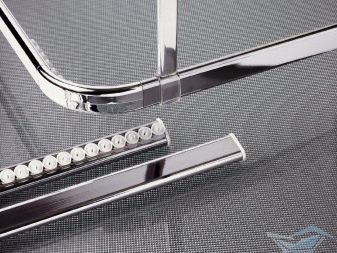
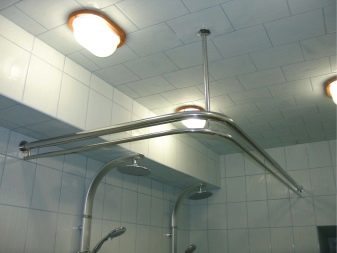
Types of designs
At the beginning of the XXI century, when creating eaves for bathrooms, they began to use a variety of materials with various shapes and fixing systems.
Below will be presented the most common types of cornices.
- Radius, semicircular or arcuate. This type of curtain rod is ideal for corner, round, asymmetric or oval bathtubs, which are installed close to the walls of the room. As a rule, such cornices have a unique arcuate shape and are fastened with special fastenings to adjacent walls. The sizes of such cornices are usually selected based on the individual preferences of the customer.
To ensure additional security, such cornices are usually mounted on vertical racks - the latter do not allow the arc to sag under the weight of the curtain. In addition, these models can be double - that is, have several rows and even towel holders at once.
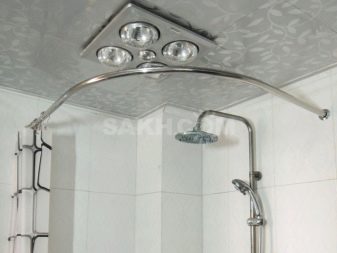
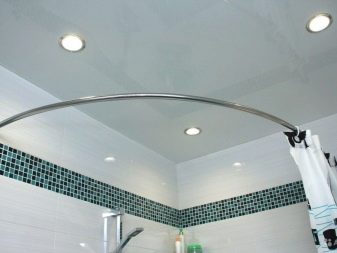
- L-shaped. This option is great for corner or rectangular bathtubs. The design of such a cornice usually includes a metal pipe (with a cross section of at least 20 mm), bent at an angle of 90 degrees and attached to two adjacent walls. Typically, these models of holders are made exclusively of durable materials that will be able to withstand the load of a heavy wet curtain.
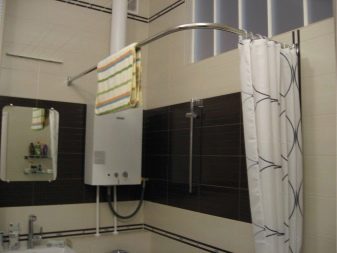
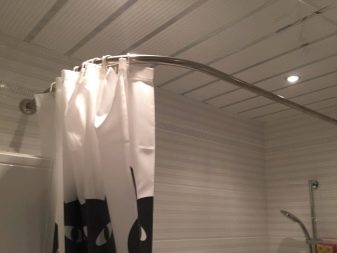
- U-shaped cornice - A universal option for oval or round bathtubs installed close to the walls. This cornice also represents an integral pipe, however, the latter is bent at right angles already in 2 places, forming the letter “P”. This version of the holders is less common and is usually made to order.
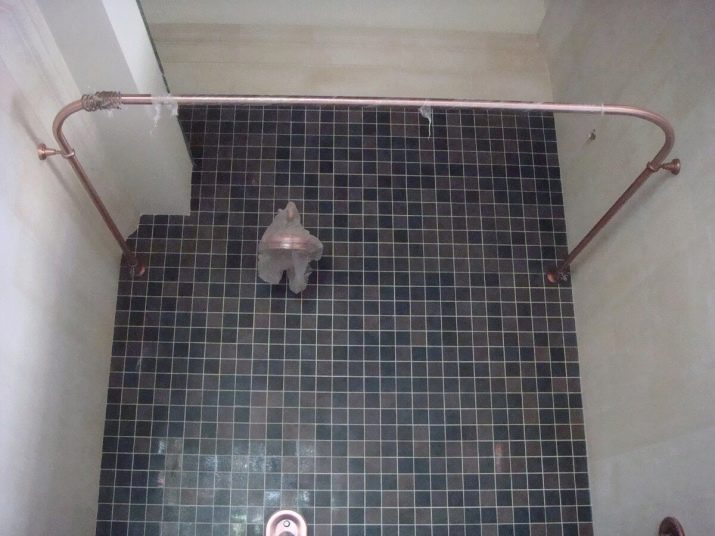
- Straight. This is the name of the classic holders in the form of straight metal or plastic arcs, which are most often found in bathrooms of standard sizes. In general, such cornices are a direct arc, which is attached to opposite walls in the bathroom.
This option is exclusively suitable for bathtubs of standard, rectangular sizes, as well as mounted close to one of the walls of the bathroom.
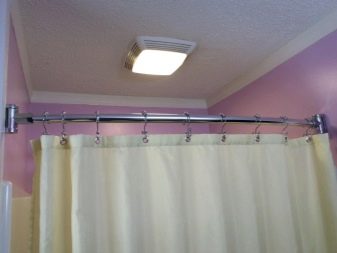

- Telescopic cornices (they are also called sliding). The peculiarity of these cornices is that they do not need special fastening. They have a unique telescopic design that allows you to stretch or reduce them to the desired length. In addition, at the ends of such holders are special rubber pads that protect the walls from damage and scratches.
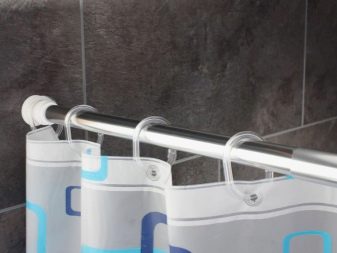
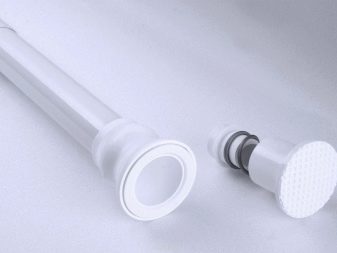
- Fan. Unique cornices that allow you to save space in the bathroom. Fan cornices consist of a series of metal or polymer knitting needles that can be folded out and assembled like a fan. This design looks original and beautiful, but because these holders usually cost a little more than other models.

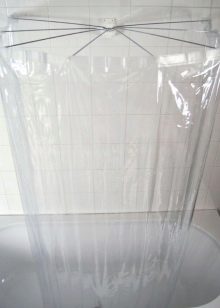

- Flexible or flexible. The peculiarity of these eaves in their soft structure, which can be adjusted to any shape and size of the bathroom. Such models are usually made of soft aluminum or durable polymers, which, even when bent, can withstand the weight of a wet curtain.
Unlike other holders, these models require a solid, additional ceiling mount.
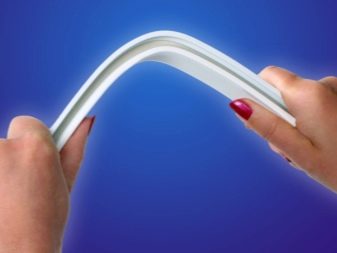
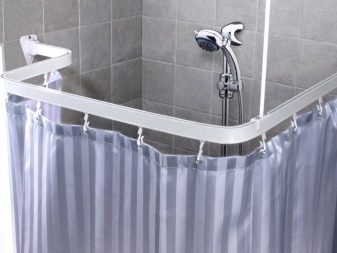
- String. As a rule, these are direct cornices, however, in this case, not a standard dense pipe, but a strong metal string is used to hold the curtain. Such cornices can be easily replaced, in addition, they do not take up much space and, due to their light weight, do not exert strong pressure on the walls.
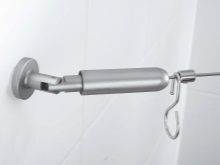

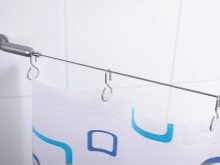
Materials of manufacture
The durability and appearance of the barbells for curtains primarily depends on the material from which they are made.Today, when creating eaves for bathrooms, about 5 different materials are used, each of which has individual indicators of strength and reliability.
- Plastic. The cheapest material from which cornices can be made is precisely plastic. It has a low weight, is able to take a variety of forms and is easily painted. In addition, plastic cornices do not emit any unpleasant sounds when opening the curtains.
Plastic holders also have disadvantages: loss of an attractive appearance in conditions of high humidity; inability to withstand significant loads from heavy curtains; the need to install additional vertical mounts or more reliable mounting to the ceiling.
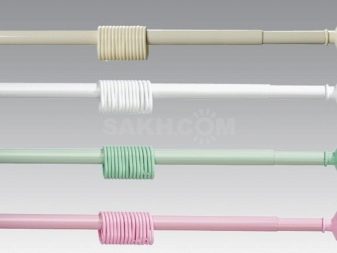
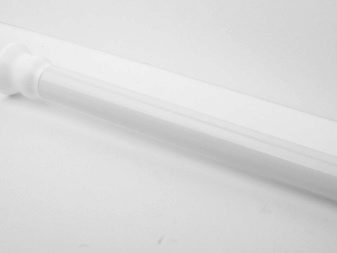
- Metal. This includes stainless steel or brushed aluminum curtain rods. These models of holders are much more expensive than plastic counterparts, however, and are distinguished by a more reliable design - they are able to withstand a significant load even from the heaviest curtains. Such cornices also need a reliable fastening, which usually includes drilling walls and installing dowels.

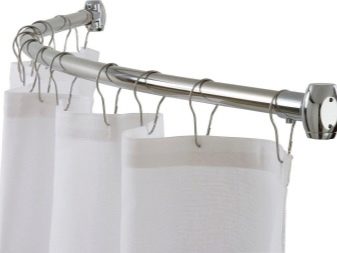
- Combined. These models of cornices include holders that combine both metal and plastic elements. Usually this is a metal pipe equipped with plastic rings with metal hooks that will not make noise when the curtains are opened.
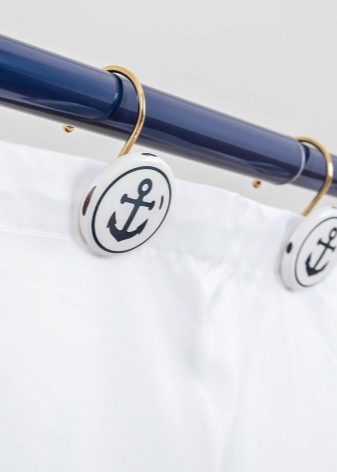
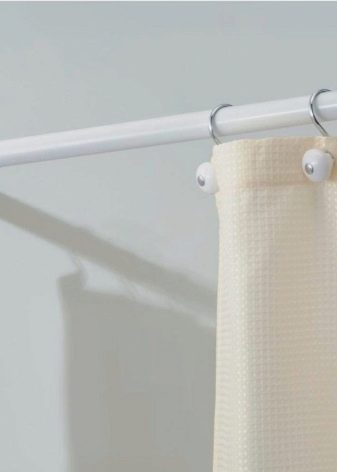
- Chrome steel. This version of the eaves will look good in any style solution, while such holders have high strength and are not susceptible to corrosion.
The only negative is that the chrome coating quickly loses its pleasant appearance from plaque after splashing water, and therefore needs frequent care.
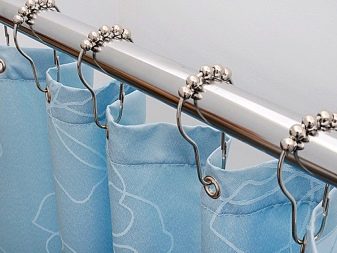
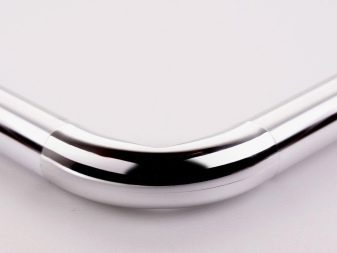
- Non-ferrous metals and alloys. This group includes all options for holders made of bronze, brass or copper. These materials look great in a certain design style, but, unfortunately, very quickly lose their appearance and deteriorate in conditions of high humidity.
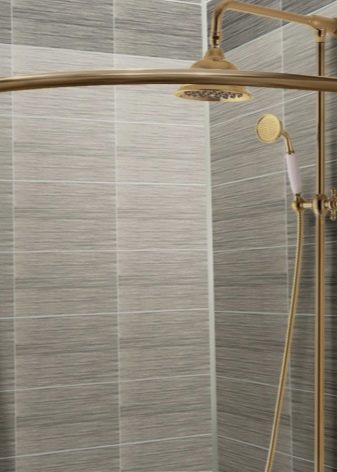
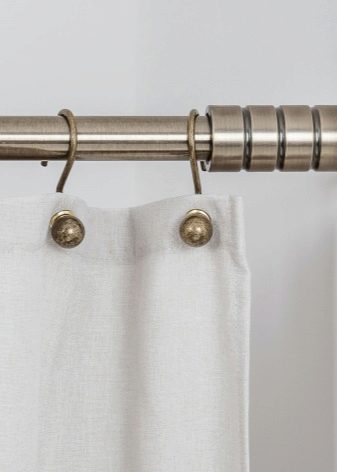
Dimensions
If we consider the presented choice of curtain rods in the market of sanitary ware for bathrooms, you will find that straight holders are usually found with a length of not more than 180 cm. As for corner, U-shaped or L-shaped options, here most often there is a size of 170x70 cm. As you can see, these numbers directly depend on the standard font sizes - the latter are usually from 160 to 180 cm in length and from 65 to 80 cm in width.
Of course, there are both shorter and longer versions of curtain rods - short for shower stalls and long for custom size bathtubs.
Fortunately, these designs consist of materials that can be adjusted to absolutely any size, so there are no clear boundaries here. It all depends solely on the preferences of the customer, the size of the font and the bathroom itself.
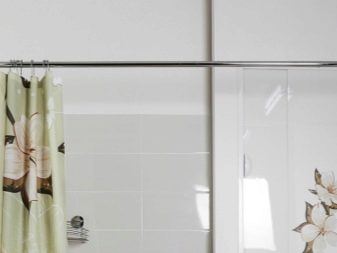
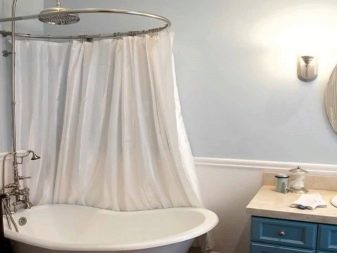
Design and colors
Many buyers choose eaves for a bathroom not only for reasons of functionality and practicality. The cornice is a full-fledged part of the interior, which can complement or update it. For each design style, experts recommend using cornices of certain materials and colors.
Below will be presented the options for using holders for curtains in the most common style solutions.
- Scandinavian style. In the case of this style, absolutely any material can be successfully used. The main task here is that it does not look alien and harmonizes with the color scheme of the room.

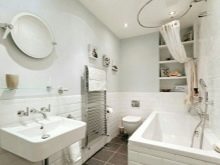
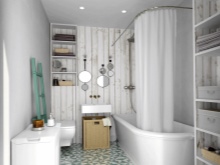
- Minimalism. This modern style sees simplicity and conciseness in everything, so both chrome and matte models are ideal here without unnecessary bulges and additional elements in the form of knots or patina. As for the material, steel, aluminum and even plastic will fit perfectly into such a bathroom.
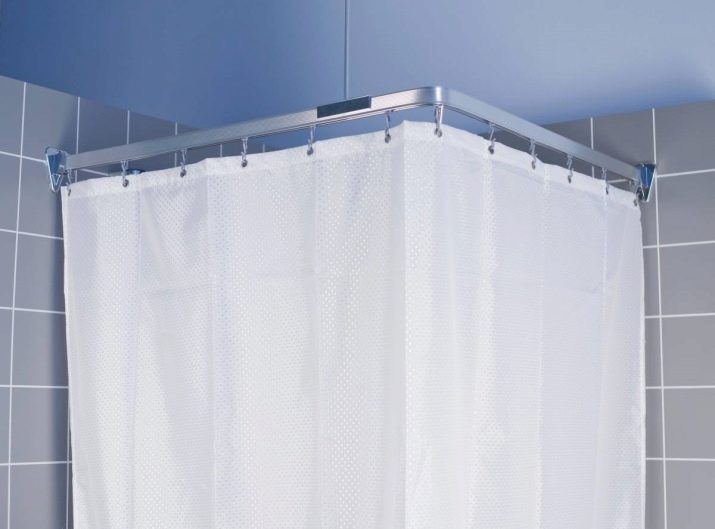
- Classic style. This style solution requires cornices, which at the same time look both concise and solid. Thin eaves of non-ferrous metals and alloys will look best in this style - items made of brass, bronze and copper, as well as coated in the form of gold, are especially popular.
What materials do not fit into this style is plastic and chrome steel.
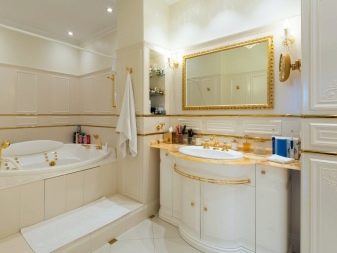
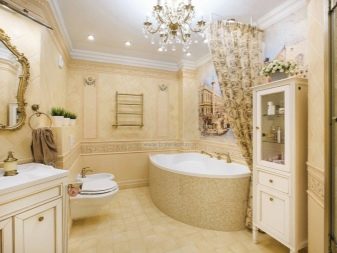
- Provence. In this case, everything very much depends on the time period in which the style was used. If we are talking about the provence of the 18th-19th centuries, the cornices made of brass, copper and bronze will look perfect here, with such a mandatory component as patina (a film in the form of patterns and colors on the surface of copper and its alloys). Provence of the modern type is more versatile - it will look great products made of chrome steel, ferrous metal and even plastic.
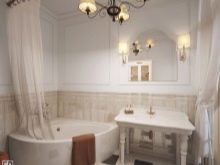
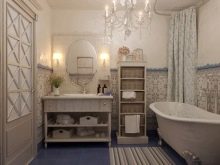
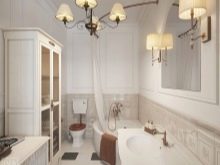
- Country and Ethno. In this style, it is recommended to give preference to matte materials, as if darkened with time. This role is excellently performed by brass, ferrous metal or copper. In this case, it is desirable to avoid chrome and steel.
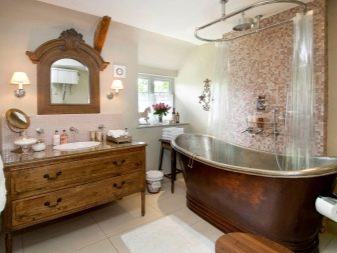
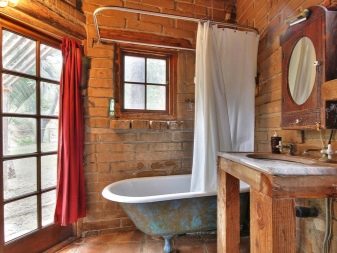
- Steampunk. In this style solution, models of holders with numerous fittings and other elements of plumbing will look perfect. Steampunk is best complemented by pipes made of copper or black metal.
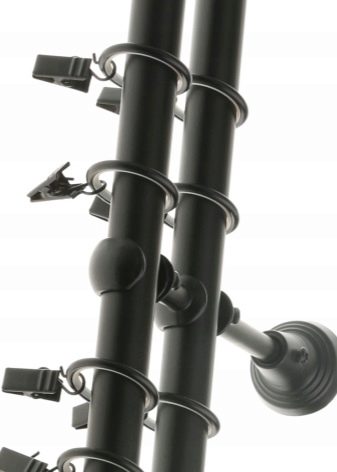
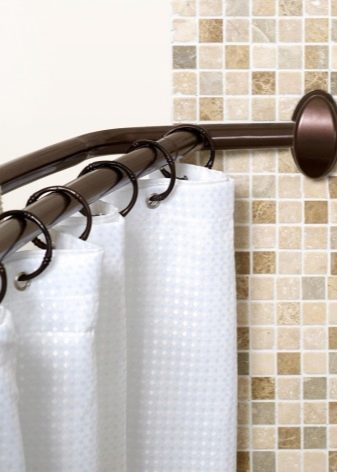
- Loft - one of the rather costly styles in the design of the bathroom, and therefore holders only of noble and solid metals and alloys: bronze, brass and copper will be appropriate here.
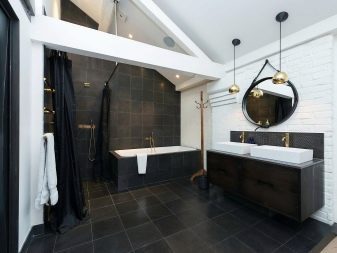
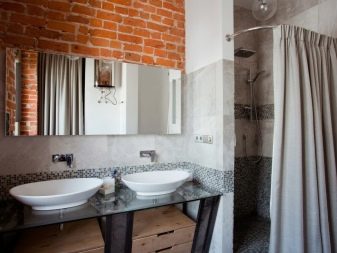
Top manufacturers
There are no brands that exclusively manufacture bathroom eaves. In general, these are manufacturers who are engaged in the creation of various plumbing for bathrooms. If we consider the most popular manufacturers of bathroom eaves, here The following brands can be distinguished: IKEA, Milardo, Ridder, Bacchetta, Iddis, Flex, Swensa, as well as Vanstore.
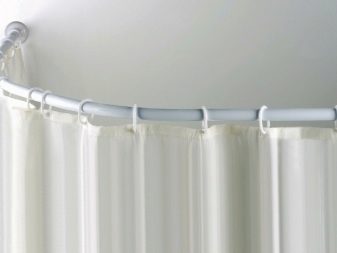
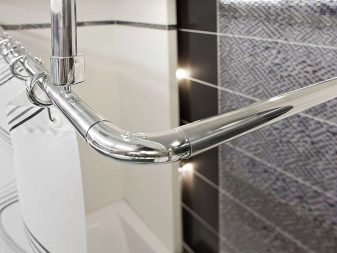
How to choose?
The choice of any plumbing for the bathroom should be treated extremely responsibly, because it is precisely its elements that form the appearance and interior of the room.
There are a number of factors to consider when choosing a cornice for a bathroom.
- Terms of Accommodation. Before choosing a model, you need to make accurate measurements of the bathroom. In particular, you need to know exactly the width of the canvas or the distance between adjacent and opposite walls on which the cornice will be mounted.
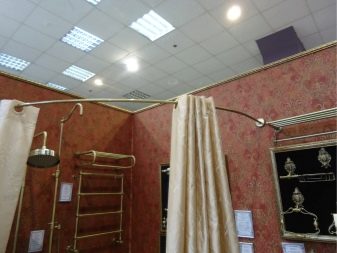

- Reliability. The most reliable material for curtain rods is stainless steel - it is incredibly strong, durable and corrosion resistant material, which also has good external characteristics.
Plastic is considered the least durable, and therefore products from this material will probably need additional fastening.
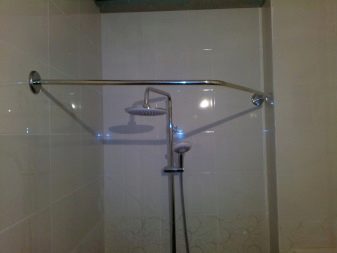
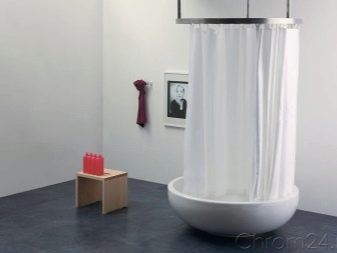
- Budget. With a modest budget, it is better to dwell on plastic models of curtain holders, however, the latter will last a maximum of 5 years. Most of the money will have to be spent on exclusive products from non-ferrous metals or alloys - they are usually installed in richly decorated bathrooms, and therefore the prices for them are corresponding. A universal option that meets the requirements of price / quality, stainless steel can be considered.
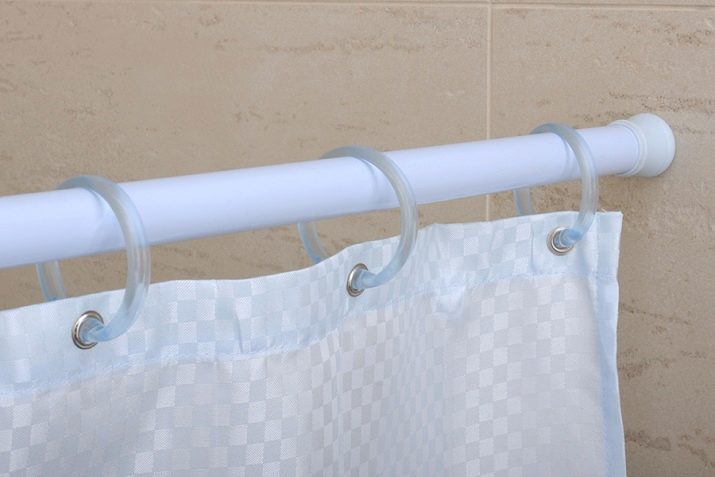
- Style. For the design of bathrooms in a special style (like classic or modern), holders made of copper or brass are usually used - they look most richly and harmonize with a warm style solution. A universal option is stainless steel and chrome steel.
Avoid holders made of thin-walled painted steel - in appearance such products may seem reliable and attractive, however, very soon the decorative coating will be erased and will be unpleasantly evident.
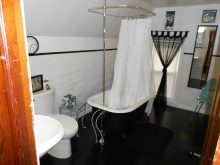
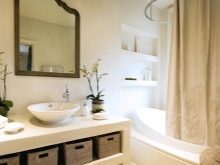
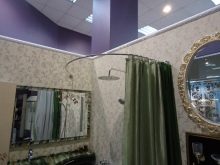
- Installation. The telescopic models of cornices are the easiest to install - even their drilling will not be necessary for their fastening. Most of the trouble will be with the installation of plastic structures and alloy products.These products can bend under light weight even with additional vertical posts. Owners of bathrooms with suspended ceilings should take into account that in their case, fixing the cornice is possible only on adjacent walls.
When installing pipes on walls, it is best to use the type of fastening with screws - this is the most reliable option.
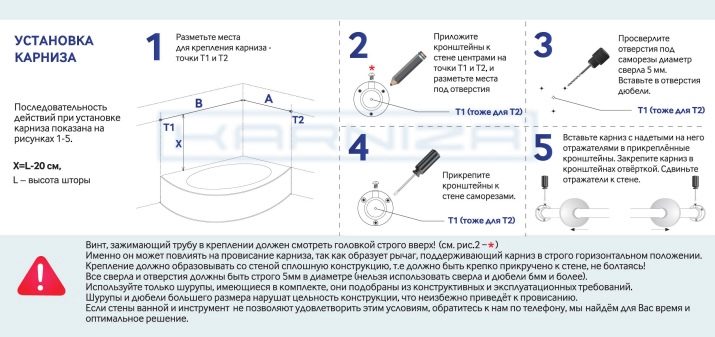
- Noise. It is the plastic versions of the holders that make the least noise, however, the latter are distinguished by poor reliability. Metal models are more reliable, however, they make a lot of noise when the curtains are constantly moving apart. As a compromise, it is better to dwell on combined options, where the design consists of a metal pipe and plastic rings. The latter should be equipped with durable metal hooks, plastic ones in the role of hooks are not suitable - after a month they will crack or break.

- Material. When choosing metal cornices, pay attention to the properties and indicators of resistance of a certain metal to a high level of humidity. Among the most resistant metals to corrosion, high temperatures, as well as to chemical cleaning agents, aluminum and stainless steel products can be noted.

- Appearance. If you choose a certain cornice already in place - be sure to inspect its surface for chips, cracks and, in the case of geometric cornices, folds in the bend.
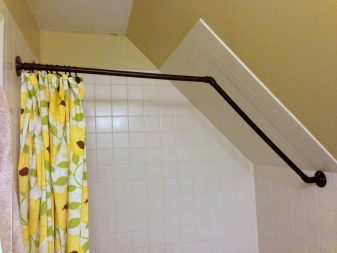

Installation Recommendations
When installing a cornice in a bathroom, it is best to use the help of specialists, however, independent installation of such structures is also possible. For high-quality installation of any holders for the bathroom, the following tools will come in handy: a drill, screwdriver, puncher, screws, dowels, pencil, drills with different diameters, as well as the construction level.
Telescopic
The installation of this holder can be considered perhaps the easiest.
- Using a level, measure 15 cm from the ceiling on both walls. Keep in mind that the curtain in a calm state should fall inside the bathroom, and not be located above the edges of the font.
- Mark the fixing points of the cornice with a regular pencil.
- Check the operability of the telescopic mechanism.
- Put hooks or rings on the crossbar, depending on the model kit.
- Place the ends of the cornice in the designated places and push the structure to the required length (with the addition of 0.5-1 cm).
- Check the reliability of the structure by hooking the curtains onto the hooks. If necessary, adjust the length of the stick.
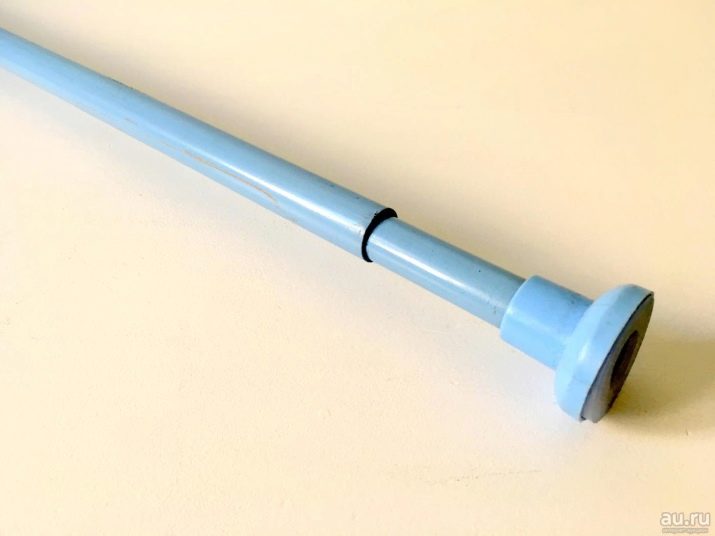
Straight
Installation of direct cornices is not much different from the installation of telescopic. The main difference is that there is a need for drilling the wall.
So, the sequence of actions.
- Using a pencil and a building level, mark the surface of the walls where the crossbar will be placed.
- Using a drill, make holes in the markings. The depth of the holes is not more than 2 cm, depending on the type and indicators of the weight of the structure.
- Place the wall plugs in the created holes so that their head protrudes no more than 0.5 cm above the surface of the wall.
- Install the brackets.
- Install the pipe into the brackets. In this case, the clamping screws should be slightly loosened.
- If necessary, place decorative linings on the edges of the cornice to hide the drilling points.

Angular
The fastening of such products can cause much more difficulties, however, the installation scheme is slightly different from the installation of standard direct options.
- Adjust the size of the bar for the font or shower. All excess length can be removed with a hacksaw.
- Indicate the places on the wall where the cornice mount will be placed.
- Hook hooks or rings onto the ledge, then place its ends in the designated places on the wall.
- Use dowels, screws or screws to secure the product.
- Check the reliability of the mounts, if necessary, install an additional mount (if such items are included).
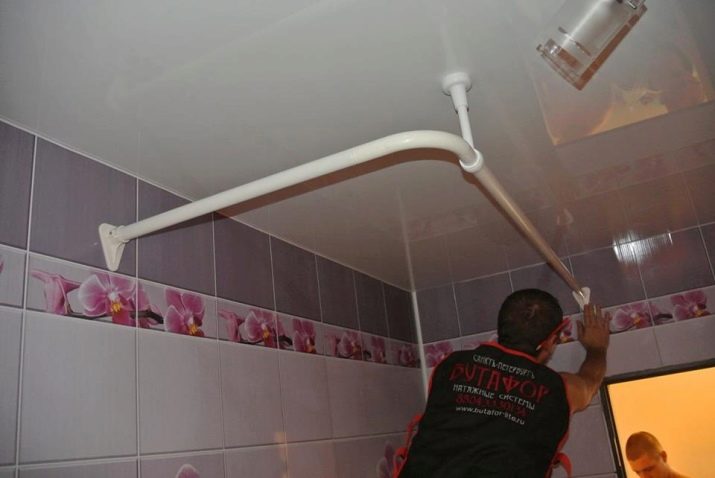
If the bar is more than necessary
In metal or plastic cornices, the dimensions of the product are adjusted in advance to the dimensions of the bathroom. Excess lengths can be cut with a hacksaw.
A completely different solution to the problem with excess length in telescopic cornices. Here, the inner spring, which fixes the position of the arc, does not let the latter into the product. In this case, the inner stick is completely removed from the main crossbar together with the spring and is placed in the hole already on the opposite side of the main stick.
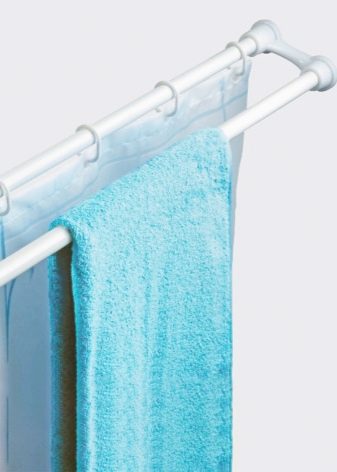
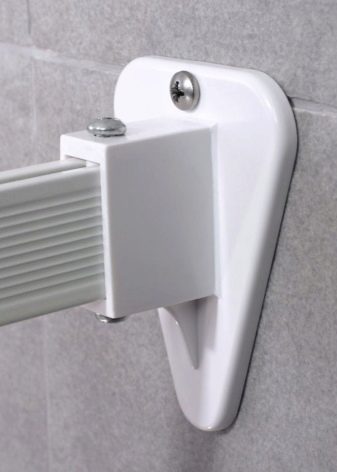
You will learn how to install a curtain rod for curtains in the bathroom from the following video.
General tips
To ensure that the holder installation procedure is completed with minimal difficulty, follow the recommendations below.
- It is not worthwhile to determine the place of attachment of the cornice by eye - use the building level.
- When installing the cornice, keep in mind that the product should ideally be at least 160 cm from the bottom of the font.
- The height of the cornice should be compared with the growth of the highest member of the family - while the cornice should be 7-10 cm higher than this indicator.
- When marking, it is better to use a regular pencil. Avoid markers, traces of which will then be difficult to remove.
- The bearing caps should be removed before mounting the telescopic cornices - they may interfere with the correct setting of the holder length.
- The hole for the clamping screw in the bracket is best placed at the top - so it will be less noticeable.
- Do not drill holes for fastening at the junction of the tiles - it will be difficult to fix them in the future.
- Remember that the most reliable and durable fasteners are considered to be ceiling mounts - they are least affected by humidity.
